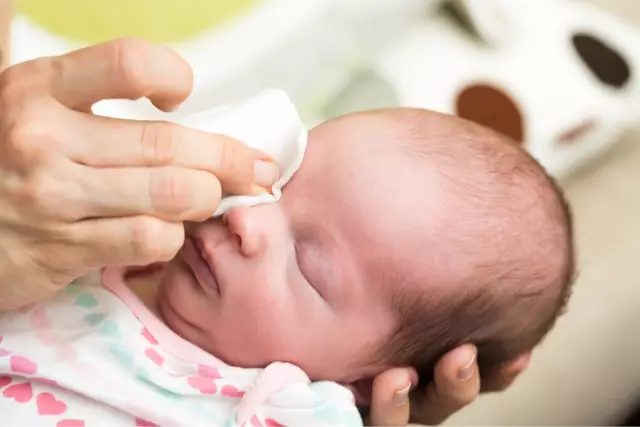- Author Curtis Blomfield [email protected].
- Public 2023-12-16 20:44.
- Last modified 2025-01-23 17:01.
The conjunctiva is a mucous membrane covering the eyeball. It is highly resistant to various infections. Human tear is a natural antibacterial composition that includes immunoglobulin, beta-lysine and lysozyme. These substances prevent the penetration of harmful microorganisms into the membrane of the eye and the occurrence of inflammation. The eyelids also have protective functions, but sometimes these barriers are not able to prevent infection.
Conjunctivitis is a fairly common eye disease in children. But it proceeds in a baby, unlike an adult, in a completely different way. The child does not sleep well, his appetite disappears, he becomes whiny and irritable.
Signs of childhood conjunctivitis are:
- photophobia;
- eyelids stick together after sleep due to purulent crusts formed on them;
- severe watering and/or pus;
- reddening of the conjunctiva and its swelling.

So, how is conjunctivitis treated? Before you get an answer to this question, you should understand what type of conjunctivitis gives the baby trouble.
Depending on the pathogens that provoked thisdisease, distinguish between bacterial, viral and allergic types.
Bacterial conjunctivitis
Formed when microbes or bacteria enter the conjunctiva of the eye. The most common are staphylococci, pneumococci, streptococci, less often - gonococci and chlamydia.
Staphylococcal or pneumococcal type of conjunctivitis is characterized by profuse suppuration and severe redness of the eye.
How is bacterial conjunctivitis treated? Treatment consists of instilling an aqueous solution of antibiotics in drops and ointments into the child's eye, the composition of which also contains antibiotics.
Viral conjunctivitis
Treatment can only be prescribed by an ophthalmologist after determining the type of virus that caused the disease. It could be herpes, enterovirus, coxsackievirus or adenovirus.

Adenoviral is the most common and contagious type. It is characterized by a rise in body temperature and redness of the eyes, combined with symptoms of a cold: runny nose, sore throat. To the question of how this type of conjunctivitis is treated, it can be answered that Poludan or Interferon drops are best used to cope with the manifestations of this type of disease.
The herpetic type is determined by the appearance around the child's eyes and / or on the edges of the eyelids of the bubbles. Accompanied by photophobia and lacrimation. It is treated with antiherpetic drugs, in particular the drug "Acyclovir".
Allergic conjunctivitis
What is the treatmentconjunctivitis of this type? First you need to find out what allergen the baby has such a reaction to. It can be commonplace house dust, household chemicals, pollen from flowering plants, a new product in the diet, and many other reasons. This type of disease is characterized by the absence of eyelid edema and redness of the mucous membrane of the eye. Both eyes are affected at the same time, the baby is worried about constant severe itching. This type of conjunctivitis is treated with immunosuppressants (Hydrocortisone or Dexamethasone drugs) and antiallergic drops (Allergodil, Allergoftal and others).

So, baby conjunctivitis. How to treat this disease in each case is now clear. Let's systematize the received information a bit.
In the first day of the disease, it is required to wash the baby's eyes every two or two and a half hours. For this, an aqueous solution of furacilin or an infusion of chamomile is perfect. Crusts must be removed after soaking them. It should be remembered that for the treatment of each eye you need to take a separate swab. This will help avoid reinfection.
In the next day, but not less than a week, the eyes can be washed up to three times during the day.
Disinfectant drops should be instilled every 3 hours. For babies, a 10% solution of the drug "Albucid" is suitable. For older children - a solution of "Levomycetin", "Vitabakt", "Eubetal" and others. As the condition improves, the numberinstillations can be reduced to 3-4 times during the day. A good effect is given by 1% ointment: "Tetracycline", "Erythromycin".
It is important to remember that if only one eye is infected, then the second one should also be instilled and washed. Very often, inflammation from one eye passes to the other.
This article covers in some detail the topic of the causes of the development of this disease in a baby and answers the question "how to treat conjunctivitis of the eye".






